
Pachinko (パチンコ) is a type of mechanical game originating in Japan and is used as both a form of recreational arcade game and much more frequently as a gambling device, filling a Japanese gambling niche comparable to that of the slot machine in Western gambling.

Pinball is a type of arcade game in which a player uses paddles to manipulate one or more balls inside a pinball machine. A pinball machine is a glass-covered cabinet containing a play field populated with lights, targets, bumpers, ramps, and various other objects depending on its design. The primary objective of the game is to score as many points as possible by hitting targets and making various shots with the flippers, before all balls "drain" at an exit usually situated at the bottom of the play field. Most pinball games are divided into turns. The game ends when all balls have ended.

Dodgeball is a team sport in which players on two teams try to throw balls and hit opponents, while avoiding being hit themselves. The objective of each team is to eliminate all members of the opposing team by hitting them with thrown balls, catching a ball thrown by an opponent, or inducing an opponent to commit a violation, such as stepping outside the court.

In the sports of baseball and softball, a batted ball is a pitch that has been contacted by the batter's bat. Depending on where the ball lands, a batted ball can become either a fair ball or a foul ball. If a batted ball is a fair ball, fielders attempt to get the batter out. A foul ball is assessed as a strike unless the batter has already accumulated two strikes, in which case the number of strikes does not increase. Batted balls are also classified by their trajectory. The most common of these trajectory-based classifications are fly balls, line drives, and ground balls.
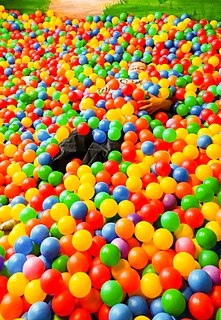
A ball pit is a padded box or pool filled with small colorful hollow plastic balls generally no larger than 3 inches (7.6 cm) in diameter. Instead of balls, other spherical objects can be used, such as balloons. It is typically employed as a recreation and exercise for children.
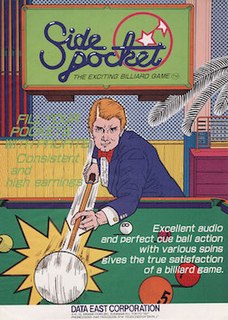
Side Pocket is a pocket billiards video game originally released into arcades by Data East in 1986. The arcade version was eventually ported to the Nintendo Entertainment System and Game Boy, while an enhanced remake was later released on the Sega Genesis, Super Nintendo Entertainment System, and the Sega Game Gear. The game also spawned two sequels, as well as arcade spin-off series titled Pocket Gal.

Pin-Bot is a pinball machine released by Williams in October 1986. It was designed by Python Anghelo and Barry Oursler.

The Addams Family, is a pinball machine released in March, 1992 by WMS industries. It was designed by Pat Lawlor and Larry DeMar and manufactured by WMS Industries. It was based on the 1991 film of the same name, and features custom speech by the stars of the film, Raul Julia and Anjelica Huston. It is the best-selling solid state pinball machine of all time with 20,270 units sold.

Zuma is a tile-matching puzzle video game published by PopCap Games. It was released for a number of platforms, including PDAs, mobile phones, and the iPod.

Black Knight is a 1980 pinball game designed by Steve Ritchie and released by Williams Electronics. Ritchie designed two sequels: Black Knight 2000, released by Williams in 1989, and Black Knight: Sword of Rage, released by Stern Pinball in 2019.
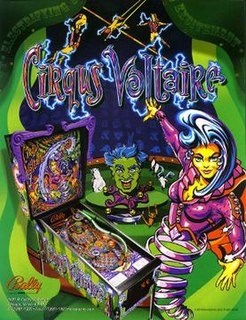
Cirqus Voltaire is a 1997 pinball game, designed by John Popadiuk and released by Williams Electronics Games. The theme involves the player performing many different marvels in order to join the circus. Some of the game's distinctive features include a neon light running along the right-hand ramp, a pop bumper that rises up from the middle of the playfield at certain times, and a magnet at the top of the left ramp that can catch balls and divert them into the locks. The most notable feature is the Ringmaster, a head that rises at certain times and taunts the player.

The Getaway: High Speed II is a 1992 pinball game by Steve Ritchie. It is a sequel to 1986's High Speed.

Fish Tales is a fishing-themed pinball game released by Williams in 1992. It is one of the top 20 most produced pinball machines of all time, selling more than 13,000 units.

Peggle is a casual puzzle video game developed by PopCap Games. Initially released for Microsoft Windows and Mac OS X systems in 2007, it has since had versions released for Xbox Live Arcade, PlayStation Network, the Nintendo DS, Windows Mobile, iOS, Zeebo, and Android; the game has also been ported as a Java application, and an extended minigame incorporated into the massively multiplayer online game World of Warcraft. A sequel was released in September 2008, titled Peggle Nights. PopCap, a subsidiary of Electronic Arts, announced Peggle 2 at E3 2013.

FunHouse is a pinball machine designed by Pat Lawlor and released in November 1990 by Williams Electronics. Starring a talking ventriloquist dummy named Rudy, the game is themed after the concept of an amusement park funhouse. FunHouse is one of the last Williams games to use an alphanumeric display; the company switched to dot matrix the following year.
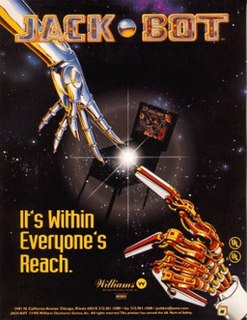
Jack-Bot is a 1995 pinball game designed by Barry Oursler and Larry DeMar, and released by Williams. It is the third game in the Pin-Bot series, following Pin-Bot (1986) and The Machine: Bride of Pin-Bot (1991).

Space Shuttle is a Space Shuttle themed pinball machine designed by Barry Oursler and Joe Kaminkow and produced in 1984 by WMS Industries. The machine's marketing slogan is "The fastest way to make your earnings really take off!". A sequel, Space Station: Pinball Rendezvous, was released in 1987.
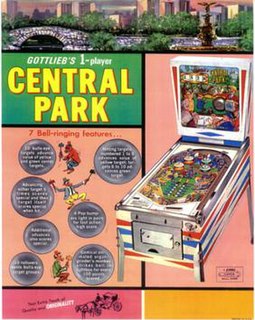
Central Park is a pinball machine that was released by Gottlieb in 1966. The game was sold in 3,100 units. It was designed by Ed Krynski and the art was done by Roy Parker.

Hurricane is a pinball machine released by Williams Electronics in August 1991. It was designed by Barry Oursler as the third game in Oursler's amusement park themed pinball trilogy. The first being Comet, released in 1985, and the second being Cyclone, released in 1988.




















